Optimizing Project Outcomes: Tailoring Methodologies to Organizations
VerifiedAdded on 2023/06/13
|17
|3963
|74
Report
AI Summary
This report provides an analysis of project management methodologies, specifically focusing on PMBOK and PRINCE2, and suggests appropriate methodologies for three different organizations based on their unique goals and project needs. It discusses the benefits of using a proper project management methodology, such as improved decision-making, controlled project scope, and timely execution. For Organization A, a manufacturer of memory chips expanding into new markets, PMBOK is recommended for its speedy and low-cost implementation. For Organization B, working on European government infrastructure projects, PRINCE2 is suggested to mitigate financial risks through controlled project implementation and risk monitoring. The report also addresses assumptions and potential issues associated with each methodology, providing mitigation strategies and emphasizing the importance of tailoring the methodology to the specific project and organizational context. Desklib offers a wide array of similar solved assignments and past papers.
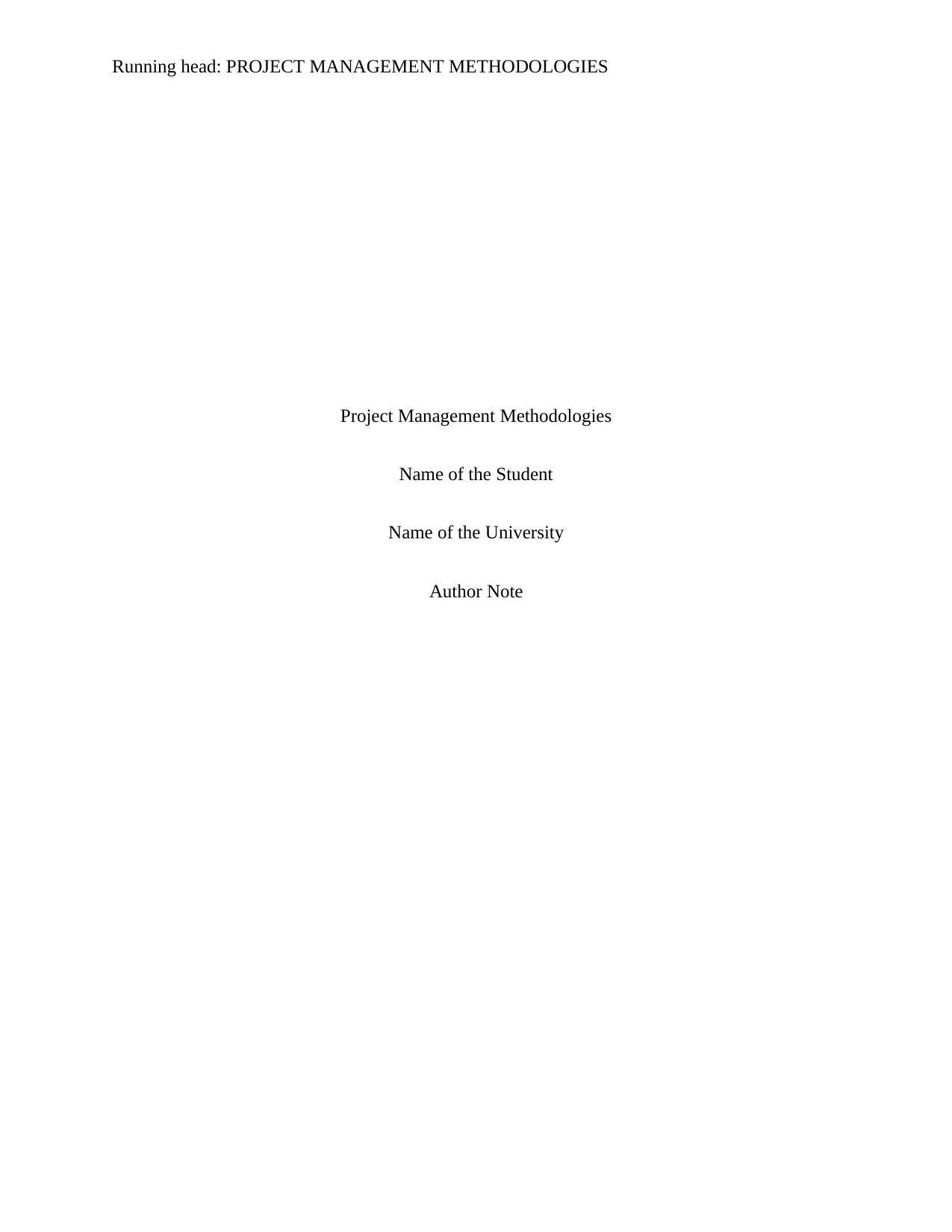
Running head: PROJECT MANAGEMENT METHODOLOGIES
Project Management Methodologies
Name of the Student
Name of the University
Author Note
Project Management Methodologies
Name of the Student
Name of the University
Author Note
Paraphrase This Document
Need a fresh take? Get an instant paraphrase of this document with our AI Paraphraser
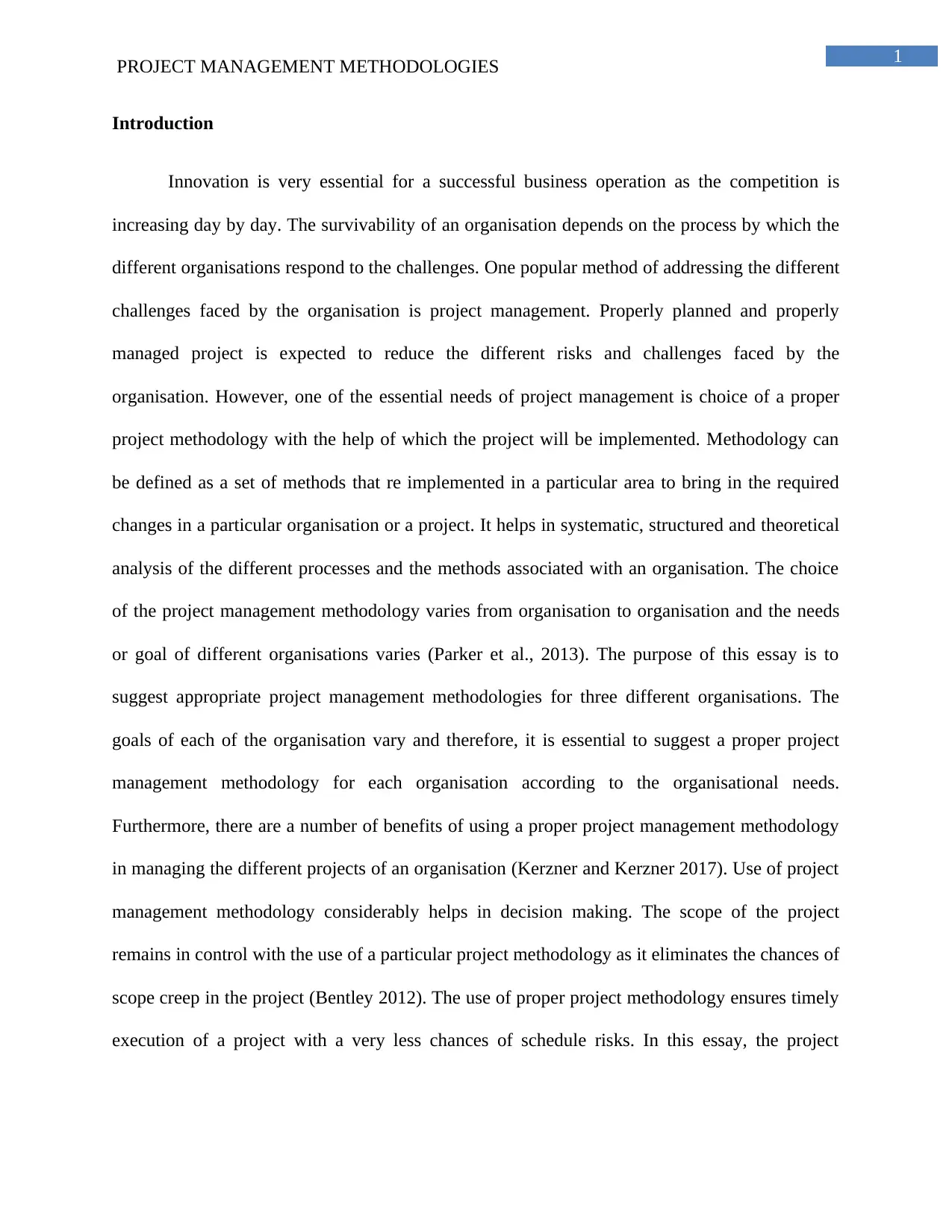
1
PROJECT MANAGEMENT METHODOLOGIES
Introduction
Innovation is very essential for a successful business operation as the competition is
increasing day by day. The survivability of an organisation depends on the process by which the
different organisations respond to the challenges. One popular method of addressing the different
challenges faced by the organisation is project management. Properly planned and properly
managed project is expected to reduce the different risks and challenges faced by the
organisation. However, one of the essential needs of project management is choice of a proper
project methodology with the help of which the project will be implemented. Methodology can
be defined as a set of methods that re implemented in a particular area to bring in the required
changes in a particular organisation or a project. It helps in systematic, structured and theoretical
analysis of the different processes and the methods associated with an organisation. The choice
of the project management methodology varies from organisation to organisation and the needs
or goal of different organisations varies (Parker et al., 2013). The purpose of this essay is to
suggest appropriate project management methodologies for three different organisations. The
goals of each of the organisation vary and therefore, it is essential to suggest a proper project
management methodology for each organisation according to the organisational needs.
Furthermore, there are a number of benefits of using a proper project management methodology
in managing the different projects of an organisation (Kerzner and Kerzner 2017). Use of project
management methodology considerably helps in decision making. The scope of the project
remains in control with the use of a particular project methodology as it eliminates the chances of
scope creep in the project (Bentley 2012). The use of proper project methodology ensures timely
execution of a project with a very less chances of schedule risks. In this essay, the project
PROJECT MANAGEMENT METHODOLOGIES
Introduction
Innovation is very essential for a successful business operation as the competition is
increasing day by day. The survivability of an organisation depends on the process by which the
different organisations respond to the challenges. One popular method of addressing the different
challenges faced by the organisation is project management. Properly planned and properly
managed project is expected to reduce the different risks and challenges faced by the
organisation. However, one of the essential needs of project management is choice of a proper
project methodology with the help of which the project will be implemented. Methodology can
be defined as a set of methods that re implemented in a particular area to bring in the required
changes in a particular organisation or a project. It helps in systematic, structured and theoretical
analysis of the different processes and the methods associated with an organisation. The choice
of the project management methodology varies from organisation to organisation and the needs
or goal of different organisations varies (Parker et al., 2013). The purpose of this essay is to
suggest appropriate project management methodologies for three different organisations. The
goals of each of the organisation vary and therefore, it is essential to suggest a proper project
management methodology for each organisation according to the organisational needs.
Furthermore, there are a number of benefits of using a proper project management methodology
in managing the different projects of an organisation (Kerzner and Kerzner 2017). Use of project
management methodology considerably helps in decision making. The scope of the project
remains in control with the use of a particular project methodology as it eliminates the chances of
scope creep in the project (Bentley 2012). The use of proper project methodology ensures timely
execution of a project with a very less chances of schedule risks. In this essay, the project
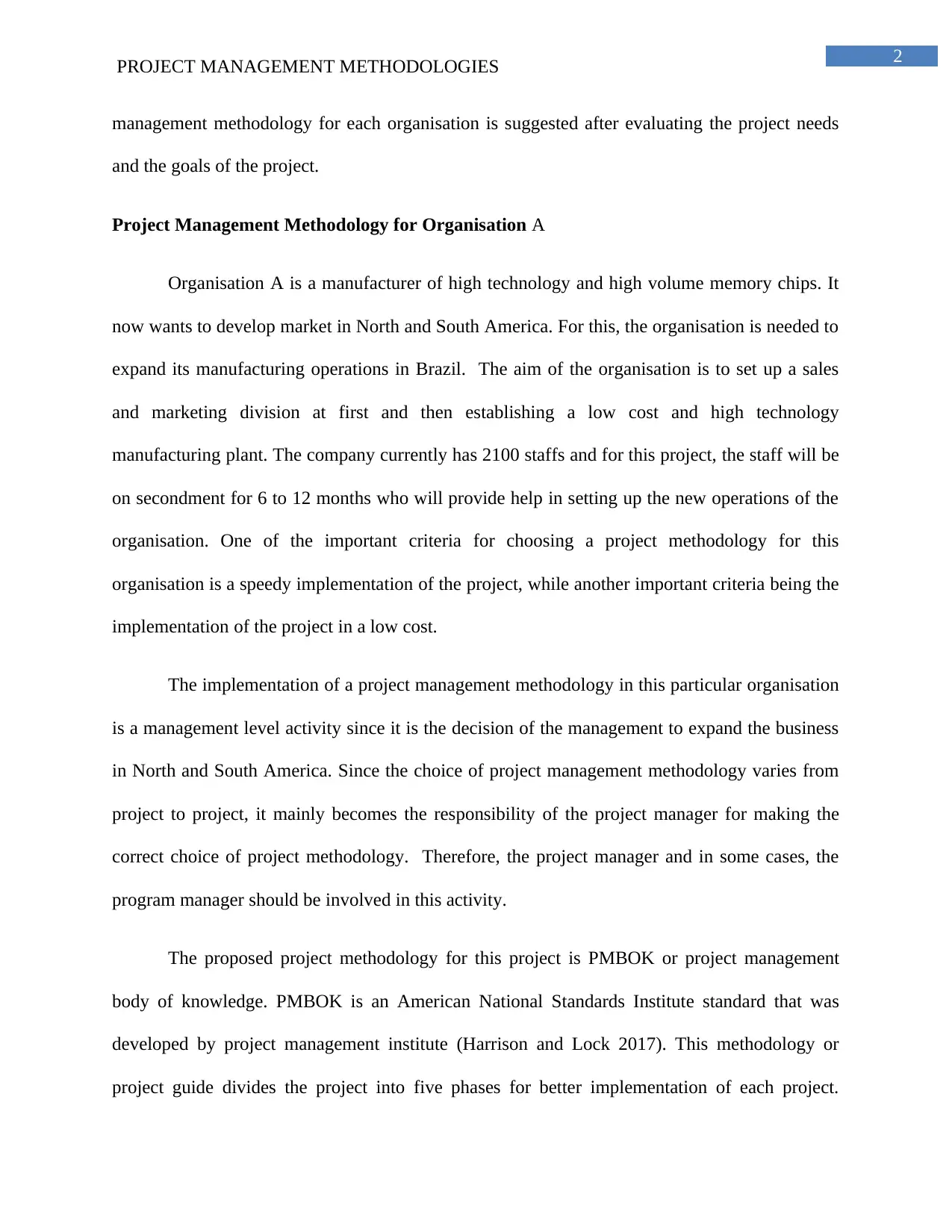
2
PROJECT MANAGEMENT METHODOLOGIES
management methodology for each organisation is suggested after evaluating the project needs
and the goals of the project.
Project Management Methodology for Organisation A
Organisation A is a manufacturer of high technology and high volume memory chips. It
now wants to develop market in North and South America. For this, the organisation is needed to
expand its manufacturing operations in Brazil. The aim of the organisation is to set up a sales
and marketing division at first and then establishing a low cost and high technology
manufacturing plant. The company currently has 2100 staffs and for this project, the staff will be
on secondment for 6 to 12 months who will provide help in setting up the new operations of the
organisation. One of the important criteria for choosing a project methodology for this
organisation is a speedy implementation of the project, while another important criteria being the
implementation of the project in a low cost.
The implementation of a project management methodology in this particular organisation
is a management level activity since it is the decision of the management to expand the business
in North and South America. Since the choice of project management methodology varies from
project to project, it mainly becomes the responsibility of the project manager for making the
correct choice of project methodology. Therefore, the project manager and in some cases, the
program manager should be involved in this activity.
The proposed project methodology for this project is PMBOK or project management
body of knowledge. PMBOK is an American National Standards Institute standard that was
developed by project management institute (Harrison and Lock 2017). This methodology or
project guide divides the project into five phases for better implementation of each project.
PROJECT MANAGEMENT METHODOLOGIES
management methodology for each organisation is suggested after evaluating the project needs
and the goals of the project.
Project Management Methodology for Organisation A
Organisation A is a manufacturer of high technology and high volume memory chips. It
now wants to develop market in North and South America. For this, the organisation is needed to
expand its manufacturing operations in Brazil. The aim of the organisation is to set up a sales
and marketing division at first and then establishing a low cost and high technology
manufacturing plant. The company currently has 2100 staffs and for this project, the staff will be
on secondment for 6 to 12 months who will provide help in setting up the new operations of the
organisation. One of the important criteria for choosing a project methodology for this
organisation is a speedy implementation of the project, while another important criteria being the
implementation of the project in a low cost.
The implementation of a project management methodology in this particular organisation
is a management level activity since it is the decision of the management to expand the business
in North and South America. Since the choice of project management methodology varies from
project to project, it mainly becomes the responsibility of the project manager for making the
correct choice of project methodology. Therefore, the project manager and in some cases, the
program manager should be involved in this activity.
The proposed project methodology for this project is PMBOK or project management
body of knowledge. PMBOK is an American National Standards Institute standard that was
developed by project management institute (Harrison and Lock 2017). This methodology or
project guide divides the project into five phases for better implementation of each project.
⊘ This is a preview!⊘
Do you want full access?
Subscribe today to unlock all pages.

Trusted by 1+ million students worldwide
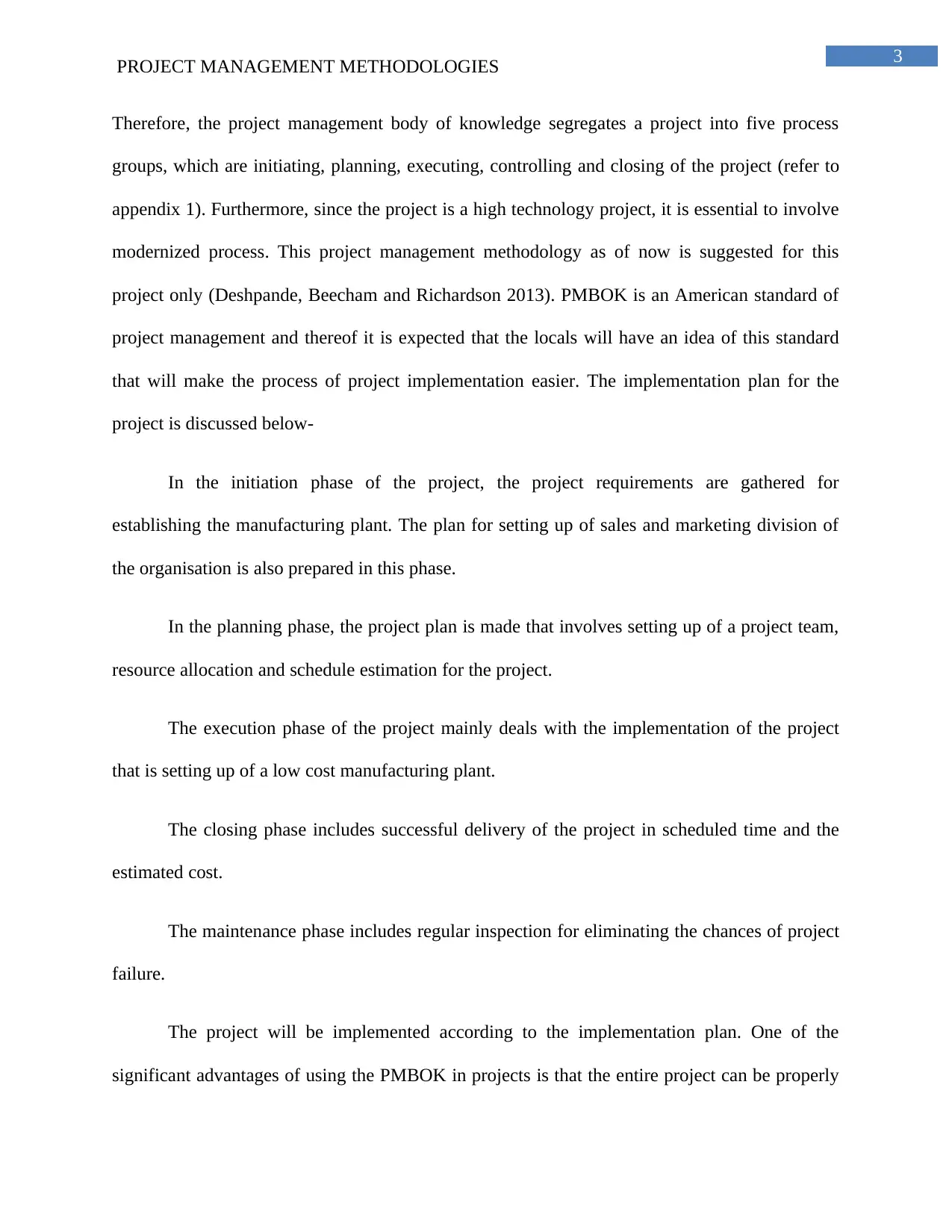
3
PROJECT MANAGEMENT METHODOLOGIES
Therefore, the project management body of knowledge segregates a project into five process
groups, which are initiating, planning, executing, controlling and closing of the project (refer to
appendix 1). Furthermore, since the project is a high technology project, it is essential to involve
modernized process. This project management methodology as of now is suggested for this
project only (Deshpande, Beecham and Richardson 2013). PMBOK is an American standard of
project management and thereof it is expected that the locals will have an idea of this standard
that will make the process of project implementation easier. The implementation plan for the
project is discussed below-
In the initiation phase of the project, the project requirements are gathered for
establishing the manufacturing plant. The plan for setting up of sales and marketing division of
the organisation is also prepared in this phase.
In the planning phase, the project plan is made that involves setting up of a project team,
resource allocation and schedule estimation for the project.
The execution phase of the project mainly deals with the implementation of the project
that is setting up of a low cost manufacturing plant.
The closing phase includes successful delivery of the project in scheduled time and the
estimated cost.
The maintenance phase includes regular inspection for eliminating the chances of project
failure.
The project will be implemented according to the implementation plan. One of the
significant advantages of using the PMBOK in projects is that the entire project can be properly
PROJECT MANAGEMENT METHODOLOGIES
Therefore, the project management body of knowledge segregates a project into five process
groups, which are initiating, planning, executing, controlling and closing of the project (refer to
appendix 1). Furthermore, since the project is a high technology project, it is essential to involve
modernized process. This project management methodology as of now is suggested for this
project only (Deshpande, Beecham and Richardson 2013). PMBOK is an American standard of
project management and thereof it is expected that the locals will have an idea of this standard
that will make the process of project implementation easier. The implementation plan for the
project is discussed below-
In the initiation phase of the project, the project requirements are gathered for
establishing the manufacturing plant. The plan for setting up of sales and marketing division of
the organisation is also prepared in this phase.
In the planning phase, the project plan is made that involves setting up of a project team,
resource allocation and schedule estimation for the project.
The execution phase of the project mainly deals with the implementation of the project
that is setting up of a low cost manufacturing plant.
The closing phase includes successful delivery of the project in scheduled time and the
estimated cost.
The maintenance phase includes regular inspection for eliminating the chances of project
failure.
The project will be implemented according to the implementation plan. One of the
significant advantages of using the PMBOK in projects is that the entire project can be properly
Paraphrase This Document
Need a fresh take? Get an instant paraphrase of this document with our AI Paraphraser
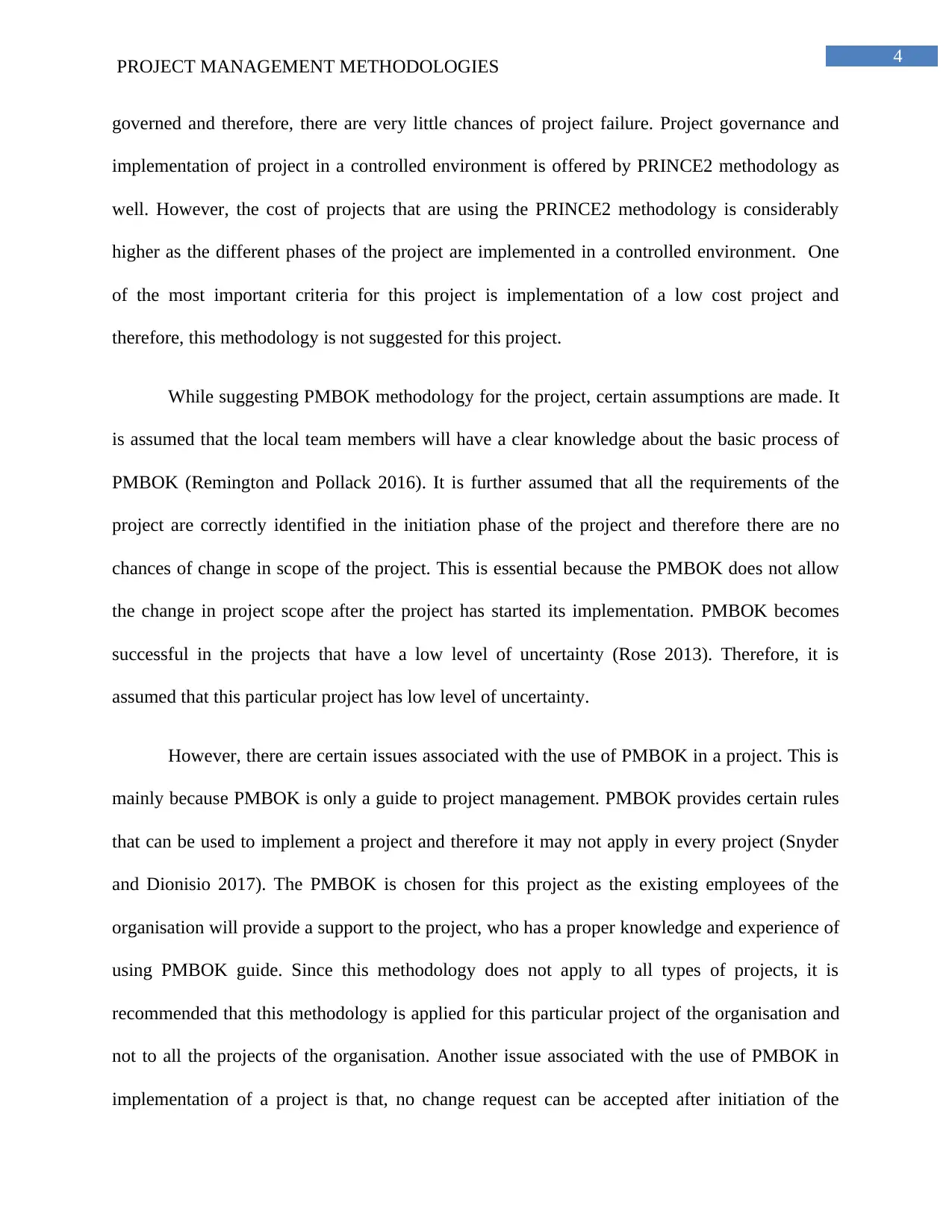
4
PROJECT MANAGEMENT METHODOLOGIES
governed and therefore, there are very little chances of project failure. Project governance and
implementation of project in a controlled environment is offered by PRINCE2 methodology as
well. However, the cost of projects that are using the PRINCE2 methodology is considerably
higher as the different phases of the project are implemented in a controlled environment. One
of the most important criteria for this project is implementation of a low cost project and
therefore, this methodology is not suggested for this project.
While suggesting PMBOK methodology for the project, certain assumptions are made. It
is assumed that the local team members will have a clear knowledge about the basic process of
PMBOK (Remington and Pollack 2016). It is further assumed that all the requirements of the
project are correctly identified in the initiation phase of the project and therefore there are no
chances of change in scope of the project. This is essential because the PMBOK does not allow
the change in project scope after the project has started its implementation. PMBOK becomes
successful in the projects that have a low level of uncertainty (Rose 2013). Therefore, it is
assumed that this particular project has low level of uncertainty.
However, there are certain issues associated with the use of PMBOK in a project. This is
mainly because PMBOK is only a guide to project management. PMBOK provides certain rules
that can be used to implement a project and therefore it may not apply in every project (Snyder
and Dionisio 2017). The PMBOK is chosen for this project as the existing employees of the
organisation will provide a support to the project, who has a proper knowledge and experience of
using PMBOK guide. Since this methodology does not apply to all types of projects, it is
recommended that this methodology is applied for this particular project of the organisation and
not to all the projects of the organisation. Another issue associated with the use of PMBOK in
implementation of a project is that, no change request can be accepted after initiation of the
PROJECT MANAGEMENT METHODOLOGIES
governed and therefore, there are very little chances of project failure. Project governance and
implementation of project in a controlled environment is offered by PRINCE2 methodology as
well. However, the cost of projects that are using the PRINCE2 methodology is considerably
higher as the different phases of the project are implemented in a controlled environment. One
of the most important criteria for this project is implementation of a low cost project and
therefore, this methodology is not suggested for this project.
While suggesting PMBOK methodology for the project, certain assumptions are made. It
is assumed that the local team members will have a clear knowledge about the basic process of
PMBOK (Remington and Pollack 2016). It is further assumed that all the requirements of the
project are correctly identified in the initiation phase of the project and therefore there are no
chances of change in scope of the project. This is essential because the PMBOK does not allow
the change in project scope after the project has started its implementation. PMBOK becomes
successful in the projects that have a low level of uncertainty (Rose 2013). Therefore, it is
assumed that this particular project has low level of uncertainty.
However, there are certain issues associated with the use of PMBOK in a project. This is
mainly because PMBOK is only a guide to project management. PMBOK provides certain rules
that can be used to implement a project and therefore it may not apply in every project (Snyder
and Dionisio 2017). The PMBOK is chosen for this project as the existing employees of the
organisation will provide a support to the project, who has a proper knowledge and experience of
using PMBOK guide. Since this methodology does not apply to all types of projects, it is
recommended that this methodology is applied for this particular project of the organisation and
not to all the projects of the organisation. Another issue associated with the use of PMBOK in
implementation of a project is that, no change request can be accepted after initiation of the
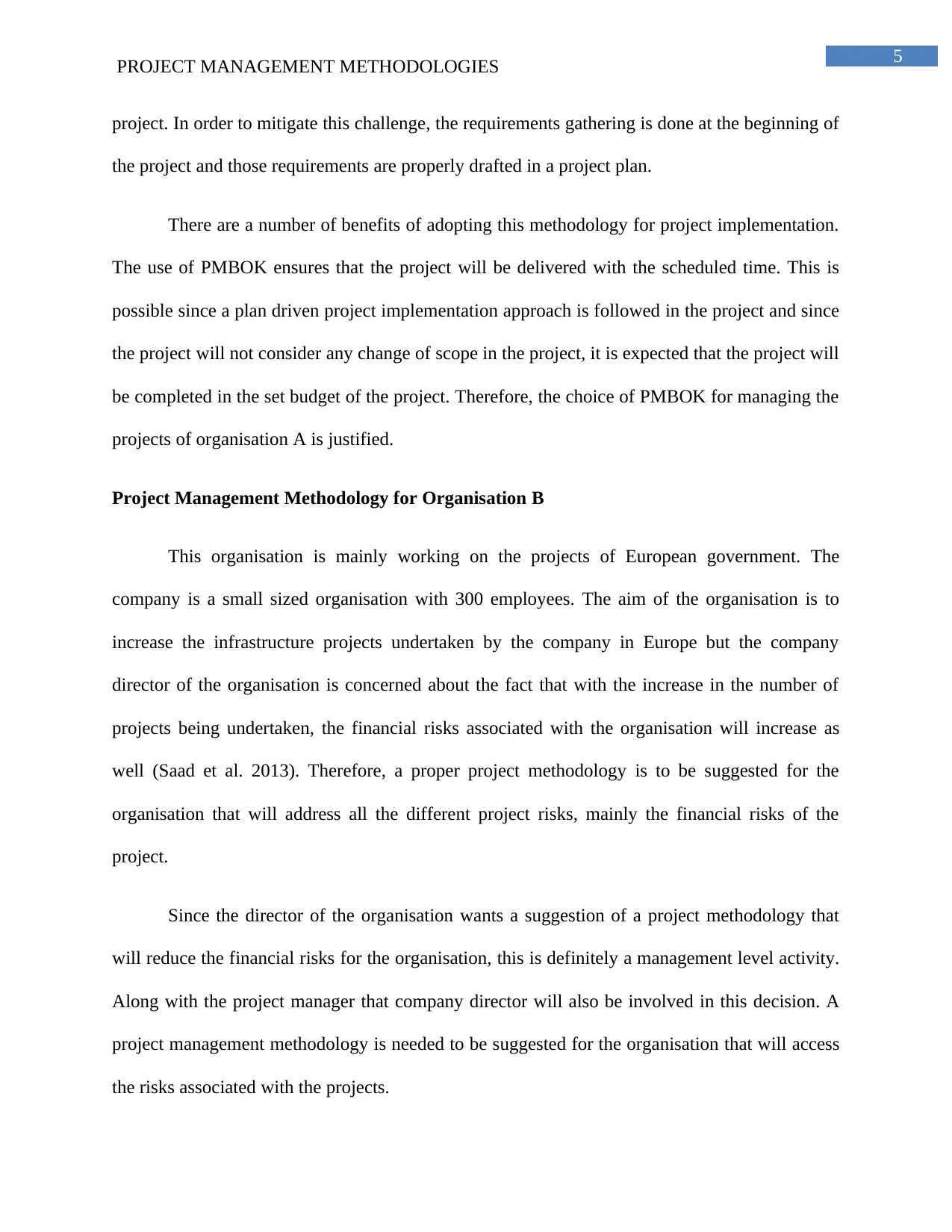
5
PROJECT MANAGEMENT METHODOLOGIES
project. In order to mitigate this challenge, the requirements gathering is done at the beginning of
the project and those requirements are properly drafted in a project plan.
There are a number of benefits of adopting this methodology for project implementation.
The use of PMBOK ensures that the project will be delivered with the scheduled time. This is
possible since a plan driven project implementation approach is followed in the project and since
the project will not consider any change of scope in the project, it is expected that the project will
be completed in the set budget of the project. Therefore, the choice of PMBOK for managing the
projects of organisation A is justified.
Project Management Methodology for Organisation B
This organisation is mainly working on the projects of European government. The
company is a small sized organisation with 300 employees. The aim of the organisation is to
increase the infrastructure projects undertaken by the company in Europe but the company
director of the organisation is concerned about the fact that with the increase in the number of
projects being undertaken, the financial risks associated with the organisation will increase as
well (Saad et al. 2013). Therefore, a proper project methodology is to be suggested for the
organisation that will address all the different project risks, mainly the financial risks of the
project.
Since the director of the organisation wants a suggestion of a project methodology that
will reduce the financial risks for the organisation, this is definitely a management level activity.
Along with the project manager that company director will also be involved in this decision. A
project management methodology is needed to be suggested for the organisation that will access
the risks associated with the projects.
PROJECT MANAGEMENT METHODOLOGIES
project. In order to mitigate this challenge, the requirements gathering is done at the beginning of
the project and those requirements are properly drafted in a project plan.
There are a number of benefits of adopting this methodology for project implementation.
The use of PMBOK ensures that the project will be delivered with the scheduled time. This is
possible since a plan driven project implementation approach is followed in the project and since
the project will not consider any change of scope in the project, it is expected that the project will
be completed in the set budget of the project. Therefore, the choice of PMBOK for managing the
projects of organisation A is justified.
Project Management Methodology for Organisation B
This organisation is mainly working on the projects of European government. The
company is a small sized organisation with 300 employees. The aim of the organisation is to
increase the infrastructure projects undertaken by the company in Europe but the company
director of the organisation is concerned about the fact that with the increase in the number of
projects being undertaken, the financial risks associated with the organisation will increase as
well (Saad et al. 2013). Therefore, a proper project methodology is to be suggested for the
organisation that will address all the different project risks, mainly the financial risks of the
project.
Since the director of the organisation wants a suggestion of a project methodology that
will reduce the financial risks for the organisation, this is definitely a management level activity.
Along with the project manager that company director will also be involved in this decision. A
project management methodology is needed to be suggested for the organisation that will access
the risks associated with the projects.
⊘ This is a preview!⊘
Do you want full access?
Subscribe today to unlock all pages.

Trusted by 1+ million students worldwide
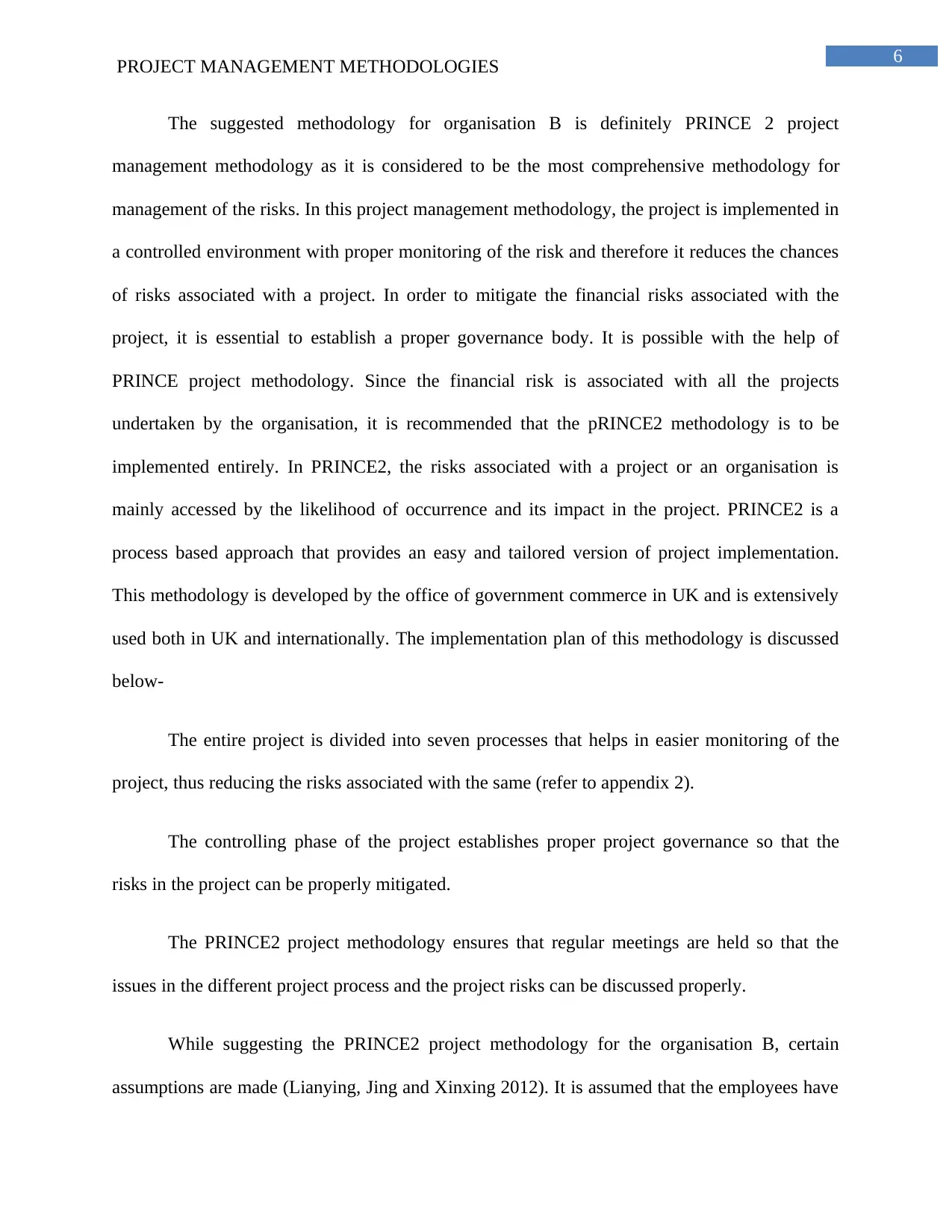
6
PROJECT MANAGEMENT METHODOLOGIES
The suggested methodology for organisation B is definitely PRINCE 2 project
management methodology as it is considered to be the most comprehensive methodology for
management of the risks. In this project management methodology, the project is implemented in
a controlled environment with proper monitoring of the risk and therefore it reduces the chances
of risks associated with a project. In order to mitigate the financial risks associated with the
project, it is essential to establish a proper governance body. It is possible with the help of
PRINCE project methodology. Since the financial risk is associated with all the projects
undertaken by the organisation, it is recommended that the pRINCE2 methodology is to be
implemented entirely. In PRINCE2, the risks associated with a project or an organisation is
mainly accessed by the likelihood of occurrence and its impact in the project. PRINCE2 is a
process based approach that provides an easy and tailored version of project implementation.
This methodology is developed by the office of government commerce in UK and is extensively
used both in UK and internationally. The implementation plan of this methodology is discussed
below-
The entire project is divided into seven processes that helps in easier monitoring of the
project, thus reducing the risks associated with the same (refer to appendix 2).
The controlling phase of the project establishes proper project governance so that the
risks in the project can be properly mitigated.
The PRINCE2 project methodology ensures that regular meetings are held so that the
issues in the different project process and the project risks can be discussed properly.
While suggesting the PRINCE2 project methodology for the organisation B, certain
assumptions are made (Lianying, Jing and Xinxing 2012). It is assumed that the employees have
PROJECT MANAGEMENT METHODOLOGIES
The suggested methodology for organisation B is definitely PRINCE 2 project
management methodology as it is considered to be the most comprehensive methodology for
management of the risks. In this project management methodology, the project is implemented in
a controlled environment with proper monitoring of the risk and therefore it reduces the chances
of risks associated with a project. In order to mitigate the financial risks associated with the
project, it is essential to establish a proper governance body. It is possible with the help of
PRINCE project methodology. Since the financial risk is associated with all the projects
undertaken by the organisation, it is recommended that the pRINCE2 methodology is to be
implemented entirely. In PRINCE2, the risks associated with a project or an organisation is
mainly accessed by the likelihood of occurrence and its impact in the project. PRINCE2 is a
process based approach that provides an easy and tailored version of project implementation.
This methodology is developed by the office of government commerce in UK and is extensively
used both in UK and internationally. The implementation plan of this methodology is discussed
below-
The entire project is divided into seven processes that helps in easier monitoring of the
project, thus reducing the risks associated with the same (refer to appendix 2).
The controlling phase of the project establishes proper project governance so that the
risks in the project can be properly mitigated.
The PRINCE2 project methodology ensures that regular meetings are held so that the
issues in the different project process and the project risks can be discussed properly.
While suggesting the PRINCE2 project methodology for the organisation B, certain
assumptions are made (Lianying, Jing and Xinxing 2012). It is assumed that the employees have
Paraphrase This Document
Need a fresh take? Get an instant paraphrase of this document with our AI Paraphraser
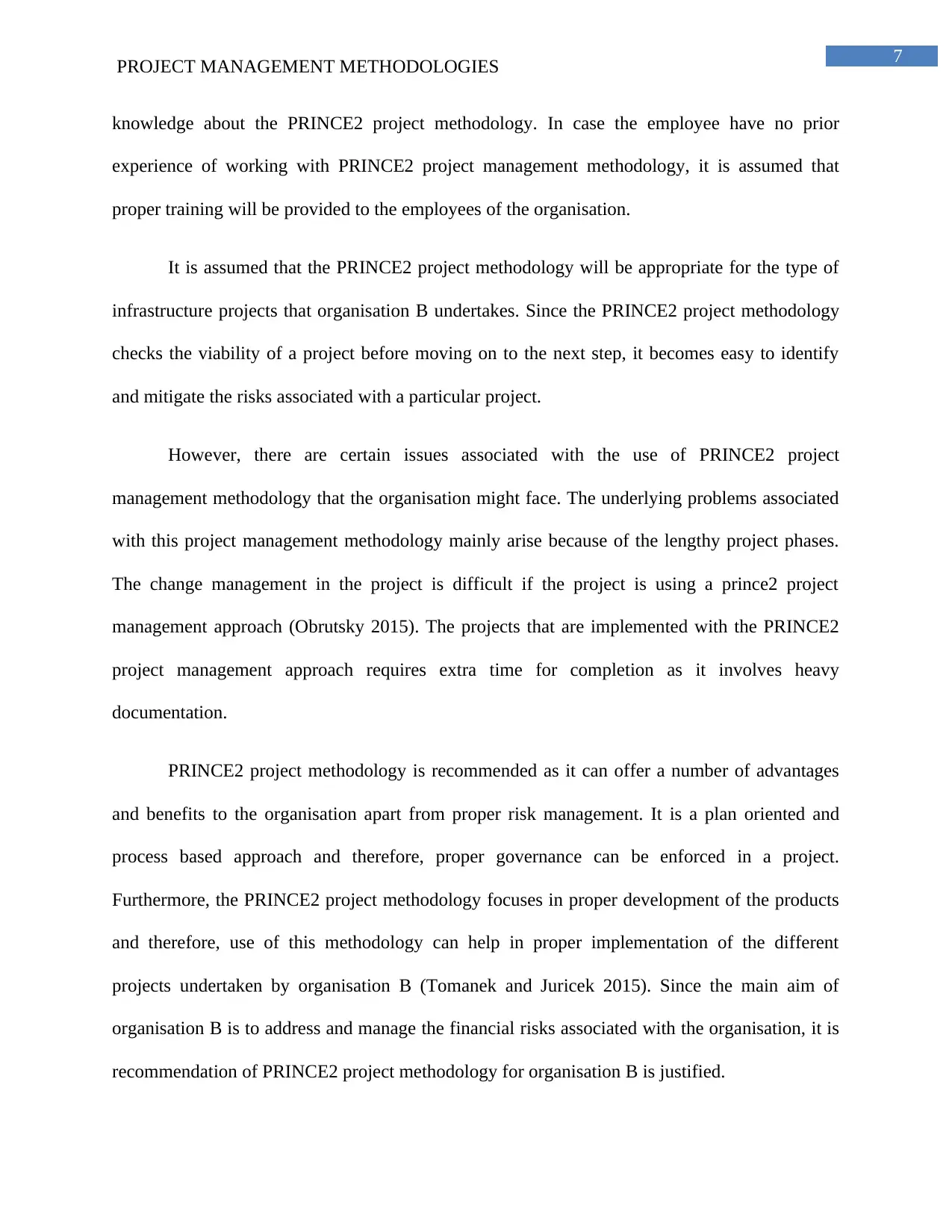
7
PROJECT MANAGEMENT METHODOLOGIES
knowledge about the PRINCE2 project methodology. In case the employee have no prior
experience of working with PRINCE2 project management methodology, it is assumed that
proper training will be provided to the employees of the organisation.
It is assumed that the PRINCE2 project methodology will be appropriate for the type of
infrastructure projects that organisation B undertakes. Since the PRINCE2 project methodology
checks the viability of a project before moving on to the next step, it becomes easy to identify
and mitigate the risks associated with a particular project.
However, there are certain issues associated with the use of PRINCE2 project
management methodology that the organisation might face. The underlying problems associated
with this project management methodology mainly arise because of the lengthy project phases.
The change management in the project is difficult if the project is using a prince2 project
management approach (Obrutsky 2015). The projects that are implemented with the PRINCE2
project management approach requires extra time for completion as it involves heavy
documentation.
PRINCE2 project methodology is recommended as it can offer a number of advantages
and benefits to the organisation apart from proper risk management. It is a plan oriented and
process based approach and therefore, proper governance can be enforced in a project.
Furthermore, the PRINCE2 project methodology focuses in proper development of the products
and therefore, use of this methodology can help in proper implementation of the different
projects undertaken by organisation B (Tomanek and Juricek 2015). Since the main aim of
organisation B is to address and manage the financial risks associated with the organisation, it is
recommendation of PRINCE2 project methodology for organisation B is justified.
PROJECT MANAGEMENT METHODOLOGIES
knowledge about the PRINCE2 project methodology. In case the employee have no prior
experience of working with PRINCE2 project management methodology, it is assumed that
proper training will be provided to the employees of the organisation.
It is assumed that the PRINCE2 project methodology will be appropriate for the type of
infrastructure projects that organisation B undertakes. Since the PRINCE2 project methodology
checks the viability of a project before moving on to the next step, it becomes easy to identify
and mitigate the risks associated with a particular project.
However, there are certain issues associated with the use of PRINCE2 project
management methodology that the organisation might face. The underlying problems associated
with this project management methodology mainly arise because of the lengthy project phases.
The change management in the project is difficult if the project is using a prince2 project
management approach (Obrutsky 2015). The projects that are implemented with the PRINCE2
project management approach requires extra time for completion as it involves heavy
documentation.
PRINCE2 project methodology is recommended as it can offer a number of advantages
and benefits to the organisation apart from proper risk management. It is a plan oriented and
process based approach and therefore, proper governance can be enforced in a project.
Furthermore, the PRINCE2 project methodology focuses in proper development of the products
and therefore, use of this methodology can help in proper implementation of the different
projects undertaken by organisation B (Tomanek and Juricek 2015). Since the main aim of
organisation B is to address and manage the financial risks associated with the organisation, it is
recommendation of PRINCE2 project methodology for organisation B is justified.
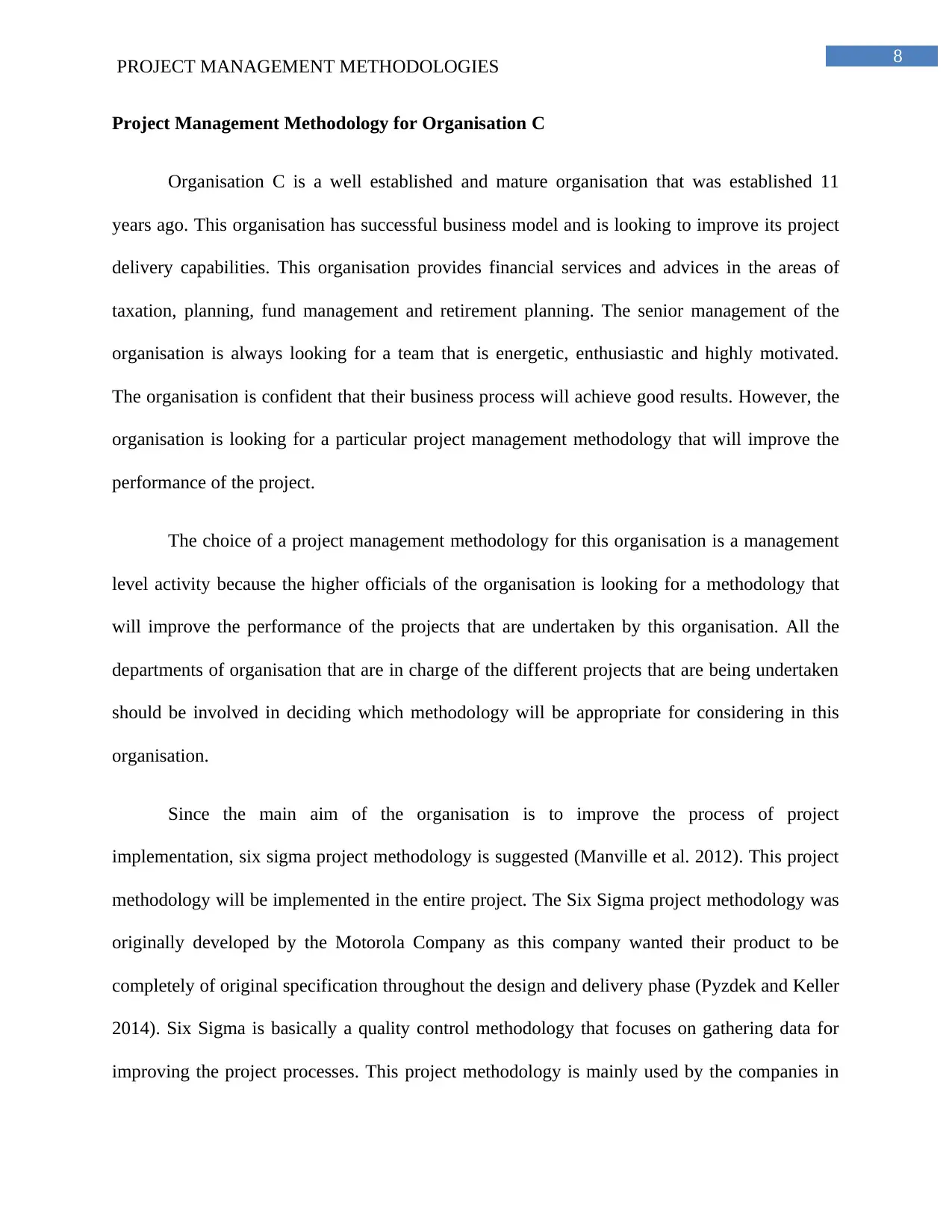
8
PROJECT MANAGEMENT METHODOLOGIES
Project Management Methodology for Organisation C
Organisation C is a well established and mature organisation that was established 11
years ago. This organisation has successful business model and is looking to improve its project
delivery capabilities. This organisation provides financial services and advices in the areas of
taxation, planning, fund management and retirement planning. The senior management of the
organisation is always looking for a team that is energetic, enthusiastic and highly motivated.
The organisation is confident that their business process will achieve good results. However, the
organisation is looking for a particular project management methodology that will improve the
performance of the project.
The choice of a project management methodology for this organisation is a management
level activity because the higher officials of the organisation is looking for a methodology that
will improve the performance of the projects that are undertaken by this organisation. All the
departments of organisation that are in charge of the different projects that are being undertaken
should be involved in deciding which methodology will be appropriate for considering in this
organisation.
Since the main aim of the organisation is to improve the process of project
implementation, six sigma project methodology is suggested (Manville et al. 2012). This project
methodology will be implemented in the entire project. The Six Sigma project methodology was
originally developed by the Motorola Company as this company wanted their product to be
completely of original specification throughout the design and delivery phase (Pyzdek and Keller
2014). Six Sigma is basically a quality control methodology that focuses on gathering data for
improving the project processes. This project methodology is mainly used by the companies in
PROJECT MANAGEMENT METHODOLOGIES
Project Management Methodology for Organisation C
Organisation C is a well established and mature organisation that was established 11
years ago. This organisation has successful business model and is looking to improve its project
delivery capabilities. This organisation provides financial services and advices in the areas of
taxation, planning, fund management and retirement planning. The senior management of the
organisation is always looking for a team that is energetic, enthusiastic and highly motivated.
The organisation is confident that their business process will achieve good results. However, the
organisation is looking for a particular project management methodology that will improve the
performance of the project.
The choice of a project management methodology for this organisation is a management
level activity because the higher officials of the organisation is looking for a methodology that
will improve the performance of the projects that are undertaken by this organisation. All the
departments of organisation that are in charge of the different projects that are being undertaken
should be involved in deciding which methodology will be appropriate for considering in this
organisation.
Since the main aim of the organisation is to improve the process of project
implementation, six sigma project methodology is suggested (Manville et al. 2012). This project
methodology will be implemented in the entire project. The Six Sigma project methodology was
originally developed by the Motorola Company as this company wanted their product to be
completely of original specification throughout the design and delivery phase (Pyzdek and Keller
2014). Six Sigma is basically a quality control methodology that focuses on gathering data for
improving the project processes. This project methodology is mainly used by the companies in
⊘ This is a preview!⊘
Do you want full access?
Subscribe today to unlock all pages.

Trusted by 1+ million students worldwide
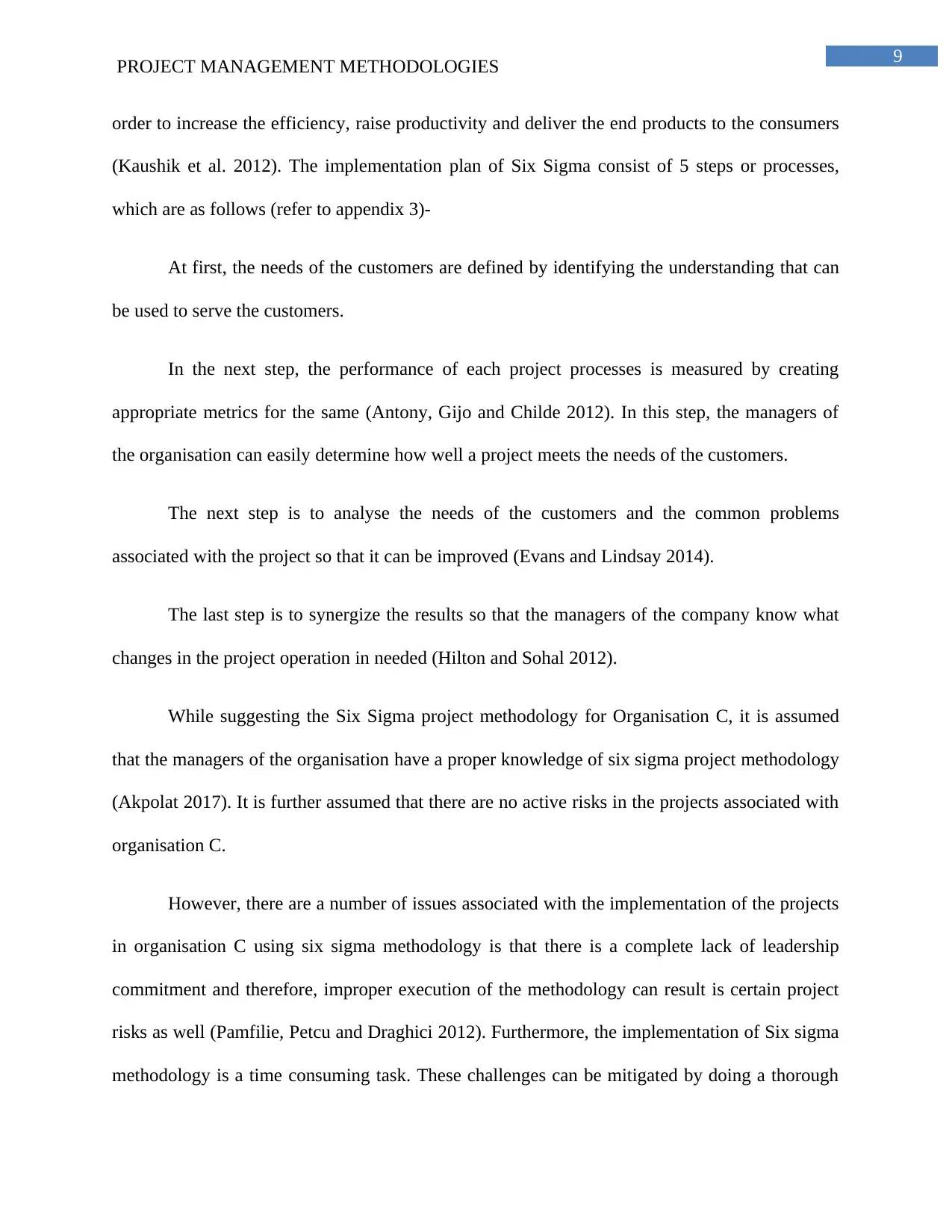
9
PROJECT MANAGEMENT METHODOLOGIES
order to increase the efficiency, raise productivity and deliver the end products to the consumers
(Kaushik et al. 2012). The implementation plan of Six Sigma consist of 5 steps or processes,
which are as follows (refer to appendix 3)-
At first, the needs of the customers are defined by identifying the understanding that can
be used to serve the customers.
In the next step, the performance of each project processes is measured by creating
appropriate metrics for the same (Antony, Gijo and Childe 2012). In this step, the managers of
the organisation can easily determine how well a project meets the needs of the customers.
The next step is to analyse the needs of the customers and the common problems
associated with the project so that it can be improved (Evans and Lindsay 2014).
The last step is to synergize the results so that the managers of the company know what
changes in the project operation in needed (Hilton and Sohal 2012).
While suggesting the Six Sigma project methodology for Organisation C, it is assumed
that the managers of the organisation have a proper knowledge of six sigma project methodology
(Akpolat 2017). It is further assumed that there are no active risks in the projects associated with
organisation C.
However, there are a number of issues associated with the implementation of the projects
in organisation C using six sigma methodology is that there is a complete lack of leadership
commitment and therefore, improper execution of the methodology can result is certain project
risks as well (Pamfilie, Petcu and Draghici 2012). Furthermore, the implementation of Six sigma
methodology is a time consuming task. These challenges can be mitigated by doing a thorough
PROJECT MANAGEMENT METHODOLOGIES
order to increase the efficiency, raise productivity and deliver the end products to the consumers
(Kaushik et al. 2012). The implementation plan of Six Sigma consist of 5 steps or processes,
which are as follows (refer to appendix 3)-
At first, the needs of the customers are defined by identifying the understanding that can
be used to serve the customers.
In the next step, the performance of each project processes is measured by creating
appropriate metrics for the same (Antony, Gijo and Childe 2012). In this step, the managers of
the organisation can easily determine how well a project meets the needs of the customers.
The next step is to analyse the needs of the customers and the common problems
associated with the project so that it can be improved (Evans and Lindsay 2014).
The last step is to synergize the results so that the managers of the company know what
changes in the project operation in needed (Hilton and Sohal 2012).
While suggesting the Six Sigma project methodology for Organisation C, it is assumed
that the managers of the organisation have a proper knowledge of six sigma project methodology
(Akpolat 2017). It is further assumed that there are no active risks in the projects associated with
organisation C.
However, there are a number of issues associated with the implementation of the projects
in organisation C using six sigma methodology is that there is a complete lack of leadership
commitment and therefore, improper execution of the methodology can result is certain project
risks as well (Pamfilie, Petcu and Draghici 2012). Furthermore, the implementation of Six sigma
methodology is a time consuming task. These challenges can be mitigated by doing a thorough
Paraphrase This Document
Need a fresh take? Get an instant paraphrase of this document with our AI Paraphraser
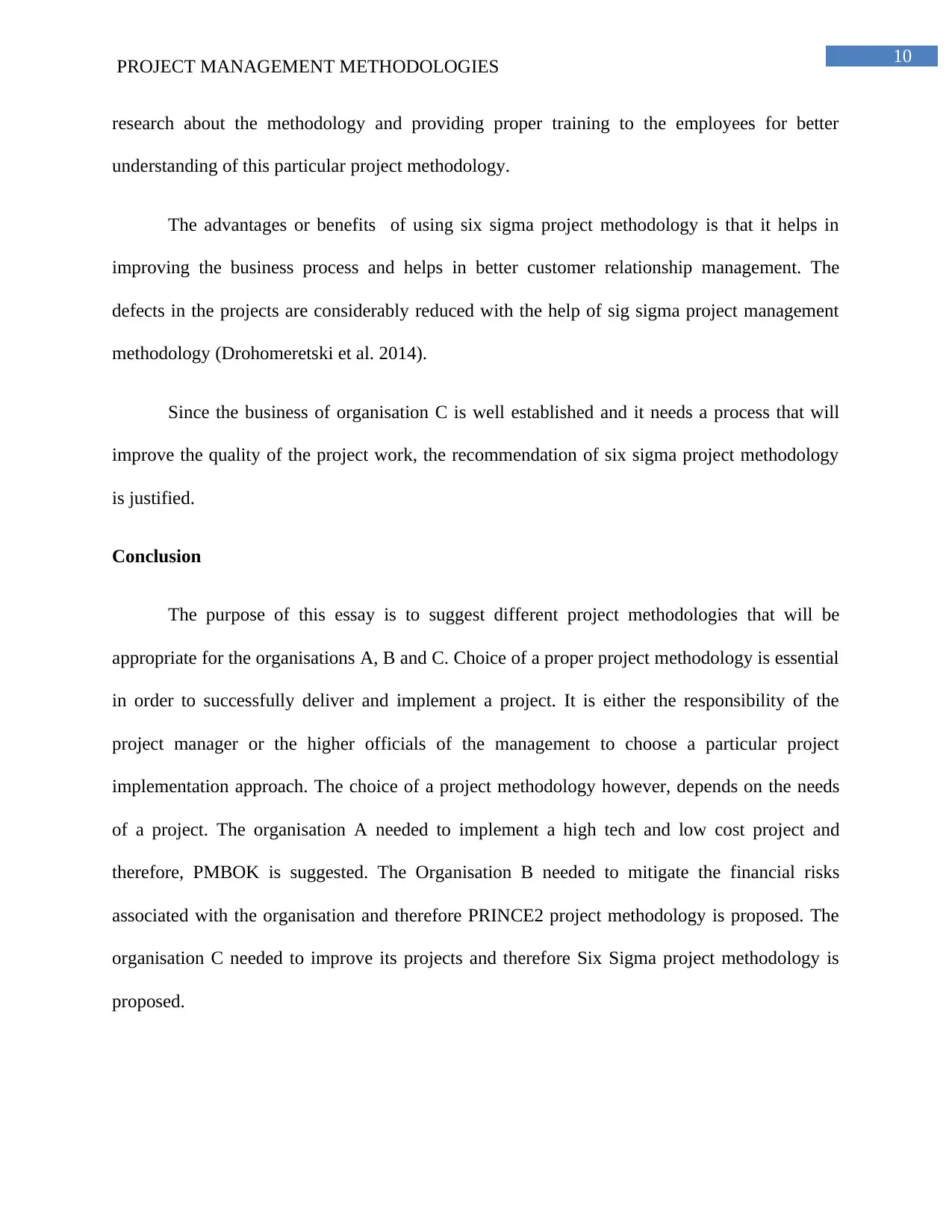
10
PROJECT MANAGEMENT METHODOLOGIES
research about the methodology and providing proper training to the employees for better
understanding of this particular project methodology.
The advantages or benefits of using six sigma project methodology is that it helps in
improving the business process and helps in better customer relationship management. The
defects in the projects are considerably reduced with the help of sig sigma project management
methodology (Drohomeretski et al. 2014).
Since the business of organisation C is well established and it needs a process that will
improve the quality of the project work, the recommendation of six sigma project methodology
is justified.
Conclusion
The purpose of this essay is to suggest different project methodologies that will be
appropriate for the organisations A, B and C. Choice of a proper project methodology is essential
in order to successfully deliver and implement a project. It is either the responsibility of the
project manager or the higher officials of the management to choose a particular project
implementation approach. The choice of a project methodology however, depends on the needs
of a project. The organisation A needed to implement a high tech and low cost project and
therefore, PMBOK is suggested. The Organisation B needed to mitigate the financial risks
associated with the organisation and therefore PRINCE2 project methodology is proposed. The
organisation C needed to improve its projects and therefore Six Sigma project methodology is
proposed.
PROJECT MANAGEMENT METHODOLOGIES
research about the methodology and providing proper training to the employees for better
understanding of this particular project methodology.
The advantages or benefits of using six sigma project methodology is that it helps in
improving the business process and helps in better customer relationship management. The
defects in the projects are considerably reduced with the help of sig sigma project management
methodology (Drohomeretski et al. 2014).
Since the business of organisation C is well established and it needs a process that will
improve the quality of the project work, the recommendation of six sigma project methodology
is justified.
Conclusion
The purpose of this essay is to suggest different project methodologies that will be
appropriate for the organisations A, B and C. Choice of a proper project methodology is essential
in order to successfully deliver and implement a project. It is either the responsibility of the
project manager or the higher officials of the management to choose a particular project
implementation approach. The choice of a project methodology however, depends on the needs
of a project. The organisation A needed to implement a high tech and low cost project and
therefore, PMBOK is suggested. The Organisation B needed to mitigate the financial risks
associated with the organisation and therefore PRINCE2 project methodology is proposed. The
organisation C needed to improve its projects and therefore Six Sigma project methodology is
proposed.
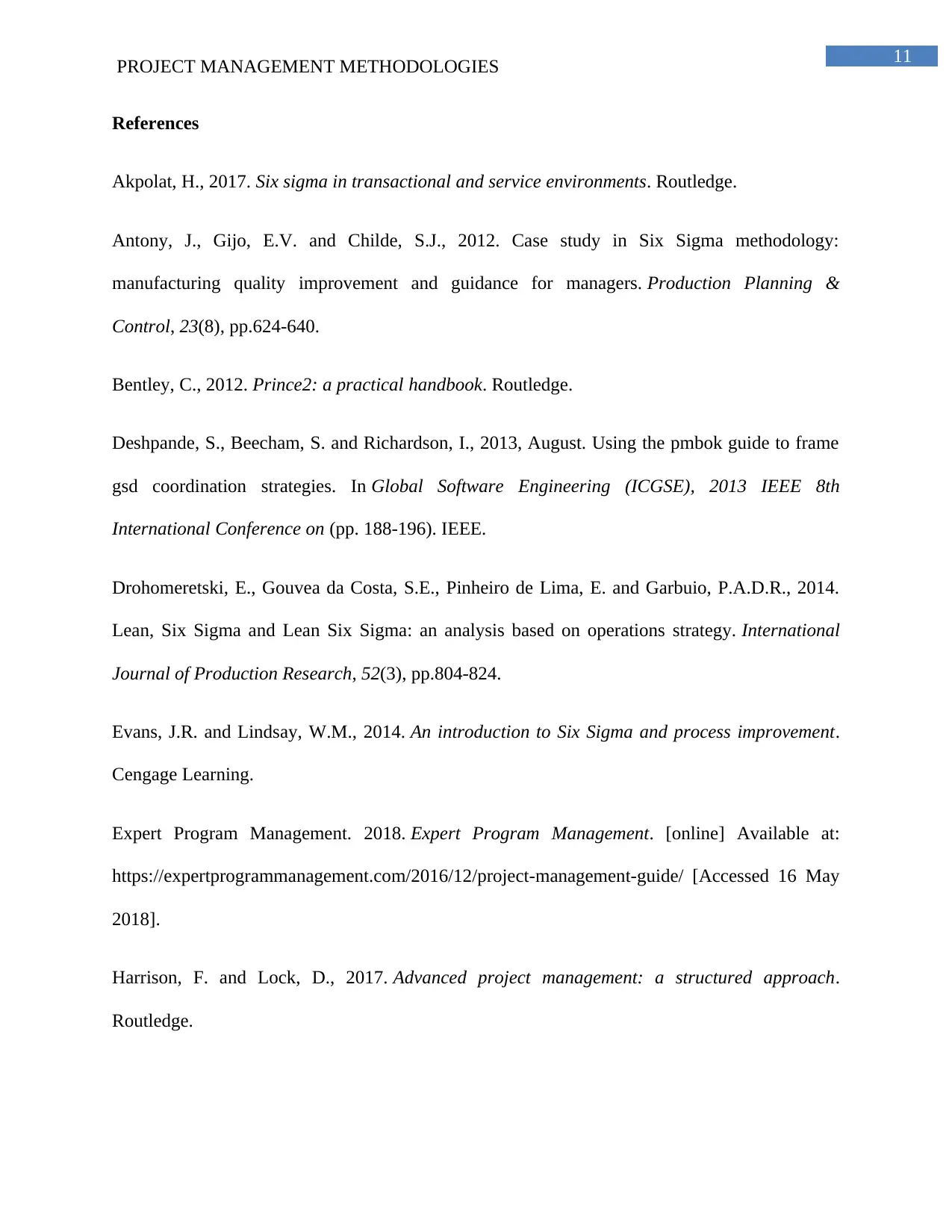
11
PROJECT MANAGEMENT METHODOLOGIES
References
Akpolat, H., 2017. Six sigma in transactional and service environments. Routledge.
Antony, J., Gijo, E.V. and Childe, S.J., 2012. Case study in Six Sigma methodology:
manufacturing quality improvement and guidance for managers. Production Planning &
Control, 23(8), pp.624-640.
Bentley, C., 2012. Prince2: a practical handbook. Routledge.
Deshpande, S., Beecham, S. and Richardson, I., 2013, August. Using the pmbok guide to frame
gsd coordination strategies. In Global Software Engineering (ICGSE), 2013 IEEE 8th
International Conference on (pp. 188-196). IEEE.
Drohomeretski, E., Gouvea da Costa, S.E., Pinheiro de Lima, E. and Garbuio, P.A.D.R., 2014.
Lean, Six Sigma and Lean Six Sigma: an analysis based on operations strategy. International
Journal of Production Research, 52(3), pp.804-824.
Evans, J.R. and Lindsay, W.M., 2014. An introduction to Six Sigma and process improvement.
Cengage Learning.
Expert Program Management. 2018. Expert Program Management. [online] Available at:
https://expertprogrammanagement.com/2016/12/project-management-guide/ [Accessed 16 May
2018].
Harrison, F. and Lock, D., 2017. Advanced project management: a structured approach.
Routledge.
PROJECT MANAGEMENT METHODOLOGIES
References
Akpolat, H., 2017. Six sigma in transactional and service environments. Routledge.
Antony, J., Gijo, E.V. and Childe, S.J., 2012. Case study in Six Sigma methodology:
manufacturing quality improvement and guidance for managers. Production Planning &
Control, 23(8), pp.624-640.
Bentley, C., 2012. Prince2: a practical handbook. Routledge.
Deshpande, S., Beecham, S. and Richardson, I., 2013, August. Using the pmbok guide to frame
gsd coordination strategies. In Global Software Engineering (ICGSE), 2013 IEEE 8th
International Conference on (pp. 188-196). IEEE.
Drohomeretski, E., Gouvea da Costa, S.E., Pinheiro de Lima, E. and Garbuio, P.A.D.R., 2014.
Lean, Six Sigma and Lean Six Sigma: an analysis based on operations strategy. International
Journal of Production Research, 52(3), pp.804-824.
Evans, J.R. and Lindsay, W.M., 2014. An introduction to Six Sigma and process improvement.
Cengage Learning.
Expert Program Management. 2018. Expert Program Management. [online] Available at:
https://expertprogrammanagement.com/2016/12/project-management-guide/ [Accessed 16 May
2018].
Harrison, F. and Lock, D., 2017. Advanced project management: a structured approach.
Routledge.
⊘ This is a preview!⊘
Do you want full access?
Subscribe today to unlock all pages.

Trusted by 1+ million students worldwide
1 out of 17
Related Documents
Your All-in-One AI-Powered Toolkit for Academic Success.
+13062052269
info@desklib.com
Available 24*7 on WhatsApp / Email
![[object Object]](/_next/static/media/star-bottom.7253800d.svg)
Unlock your academic potential
Copyright © 2020–2025 A2Z Services. All Rights Reserved. Developed and managed by ZUCOL.




